Introduction
Have you ever encountered a marketing campaign that felt like it was speaking directly to you? The kind that resonates so well that you feel an instant connection with the brand? That’s the power of Account-Based Marketing (ABM). But how to build an SaaS ABM strategy that achieves this level of personalization and relationship-building? It starts with moving away from generic, one-size-fits-all approaches and focusing on tailored, high-value engagements with your ideal customers. ABM isn’t just about generating leads; it’s about treating each account like it’s the only account. It’s about ditching the spray-and-pray approach in favor of laser-focused, tailored outreach that truly speaks to the needs of your prospects. An ABM Alliance Research Shows that companies that have implemented ABM have seen a lift in average annual contract value of 171%.Whether you're targeting one dream account or engaging fifty, the core principles remain the same:
- Genuine personalization – Making prospects feel valued through tailored engagement.
- Building trust-based relationships – Establishing credibility for long-term success.
- Focusing on high-value partnerships – Prioritizing efforts where they drive the most impact.
These ABM principles aren’t new—they’ve been used for generations by businesses that understand the power of strategic relationship-building. In this post, I’ll walk you through three powerful ABM approaches, sharing real-world ABM implementation stories and actionable strategies that I’ve personally tested and seen work.
When One Account Is All That Matters: The Magic of 1:1 ABM
The Story of Bert Hardy and Rupert Murdoch, When Rupert Murdoch began building his media empire, he acquired his first newspaper, The News, in Adelaide, Australia, in 1953.His biggest challenge? Attracting advertisers to a small, regional paper with limited reach. Enter Bert Hardy, the advertising manager Murdoch hired to tackle this challenge with an unconventional strategy.
The Gift Strategy: Personalization at Its Best Hardy understood that business success in advertising was built on relationships. Instead of cold pitches and generic outreach, he took a personalized approach. To capture the attention of potential advertisers, he sent them customized gifts—a pair of cufflinks engraved with the recipient’s initials. This small but thoughtful gesture made decision-makers feel special and valued, creating an emotional connection before any business discussions even took place.
Why It Worked:
- Hyper-Personalization (1:1 ABM): The engraved cufflinks showed thoughtfulness and effort, making recipients feel important.
- Relationship-Building: The gifts helped establish trust, breaking the ice in an era when businesses relied heavily on personal connections.
- Focus on High-Value Accounts: Hardy understood that a few key advertisers could drive the majority of revenue, so he prioritized them over mass outreach.
The Outcome: This gifting strategy transformed the paper’s advertising revenue. By making high-value advertisers feel seen and appreciated, Hardy secured major ad contracts, leading to a surge in ad revenue. This revenue boost allowed Murdoch to further expand his media empire—demonstrating how a well-executed 1:1 ABM strategy can create long-term, compounding success.
My Modern Take on 1:1 ABM
“ABM works. Done right, ABM leads to significantly higher ROI than any other marketing approach.” — Bev Burgess, an SVP and ABM Practice Leader at Momentum ITSMA The principles of personal connection that worked so well for Hardy are just as powerful today - we've just adapted them for the digital world. One such modern approach involved reaching out to the Editor-in-Chief of Vogue for a brand collaboration. To capture their attention, we created a custom digital magazine in a Vogue-style format, featuring:
- Branded content presented as high-end editorial pieces.
- Personalized cover designs that aligned with Vogue’s brand aesthetics.
- Exclusive insights into how the collaboration could benefit their audience.
This approach works because it mirrors Hardy’s strategy—tailored, exclusive, and relationship-driven. By crafting something unique and relevant to the recipient, the outreach was both memorable and effective. 1:1 ABM isn’t about reaching more people—it’s about reaching the right people in the most impactful way. Deep personalization and a strategic approach can turn a cold prospect into a valuable, long-term relationship. The smallest gestures, when executed thoughtfully, can drive the biggest business wins.
Read→13 key ABM metrics to track today
Getting Creative with Research: How to Build an ABM Strategy for 1:Few ABM
While 1:1 ABM is highly effective, companies sometimes need to scale personalization without losing strategic depth. This is where 1:Few ABM comes in.
What is 1:Few ABM?
- Focuses on a select group of high-value accounts that share common characteristics, challenges, and goals.
- Requires deeper research to personalize outreach at scale while maintaining relevance.
- This differs from 1:1 ABM, where every interaction is tailored to a single account.
Job Portals Transformed my ABM Research
A key challenge in executing 1:Few ABM effectively is identifying meaningful data sources that provide relevant insights into these target accounts. In 2006, while leading lead generation at KPIT Cummins, I was tasked with profiling accounts using job portals like Naukri and Dice. At first, it seemed odd—how could job boards, meant for hiring, help with ABM planning? The company had just acquired a smaller firm specializing in automotive products for large OEMs. Our goal was to cross-sell and upsell business IT solutions to these OEMs. My team needed to develop a plan:
- Identify key insights about the OEMs.
- Create detailed account plans for each one.
- Share insights with Sales for targeted outreach.
Traditionally, account profiling relied on
- Business Directories
- Industry reports
- Company websites
The idea of leveraging job portals felt unconventional, but I soon discovered a plethora of insights. By searching for keywords like Account name + Competitor name, I found resumes of professionals who had worked with these accounts. These resumes provided valuable details:
- Project names
- Team sizes
- Project durations
- Key Responsibilities
Beyond this, job portals also revealed hiring patterns and job descriptions that indicated an organization's investment in new projects, technology adoption, and business expansion strategies. Understanding these trends allowed us to anticipate when a company might need a particular service or solution. While pricing information was missing, we could make fairly accurate assumptions based on project size and duration. This data gave our sales team a significant edge, allowing for highly personalized outreach and marketing strategies.
Turning Resumes into Actionable Intelligence
We didn’t stop at extracting resume data. To gain deeper insights, we interviewed professionals who had uploaded their resumes. Many willingly shared:
- Challenges they faced
- Decision-making processes
- Vendors they worked with
These insights helped us understand what the accounts needed, how decisions were made, who the key stakeholders were, and what pain points needed to be addressed.
Using Job Postings for Smarter ABM Execution
We also analyzed job postings to see which technologies and skills companies were prioritizing. These job postings mattered because:
- They reveal strategic initiatives months before public announcements.
- Each job description is a window into a company’s plans, tech investments, and growth directions.
If an account was hiring for AI and machine learning specialists, for example, we knew they were likely investing in those areas and could tailor our outreach accordingly. This 1:Few ABM strategy allowed us to build hyper-personalized sales pitches, giving us a competitive advantage over companies relying solely on broad market research.
Scaling ABM with Research-Driven Insights
The success of our job portal research approach led us to develop a systematic method for identifying and grouping similar accounts based on a few key factors such as
- Technology adoption patterns
- Growth initiatives
- Organizational challenges
- Market positioning
For each cluster, we developed semi-customized content that addressed their shared challenges while maintaining enough specificity to resonate with individual companies within the group. This approach allowed us to maintain the essence of personalization while achieving greater efficiency in our outreach efforts.
Building on Past Success: Applying 1:Few ABM
Taking the lessons learned from KPIT Cummins, I applied these principles at Kissflow, where we faced a similar challenge: scaling ABM beyond a 1:1 approach without making it feel generic. The challenge was clear: how do we approach ABM implementation to personalize outreach for multiple high-value accounts while ensuring the messaging is relevant, timely, and engaging?
Finding the Right Accounts for Implementing ABM(Not Just Any Big Logo)
A common mistake in ABM is picking big names because they look good on a customer list. Instead, we focused on:
- High-intent accounts—those already showing signs of needing a solution like Kissflow.
- Hiring signals—companies bringing in automation experts or digital transformation leads.
- Competitive shifts—accounts looking for alternatives to our competitors.
Using LinkedIn Sales Navigator, ZoomInfo, and job postings, we built a shortlist of accounts that weren’t just in our ICP but were actively looking for solutions like ours. Then, we grouped them into micro-segments—clusters of accounts that shared similar challenges. This allowed us to craft personalized messaging at scale, making outreach feel relevant without writing a new playbook for each company.
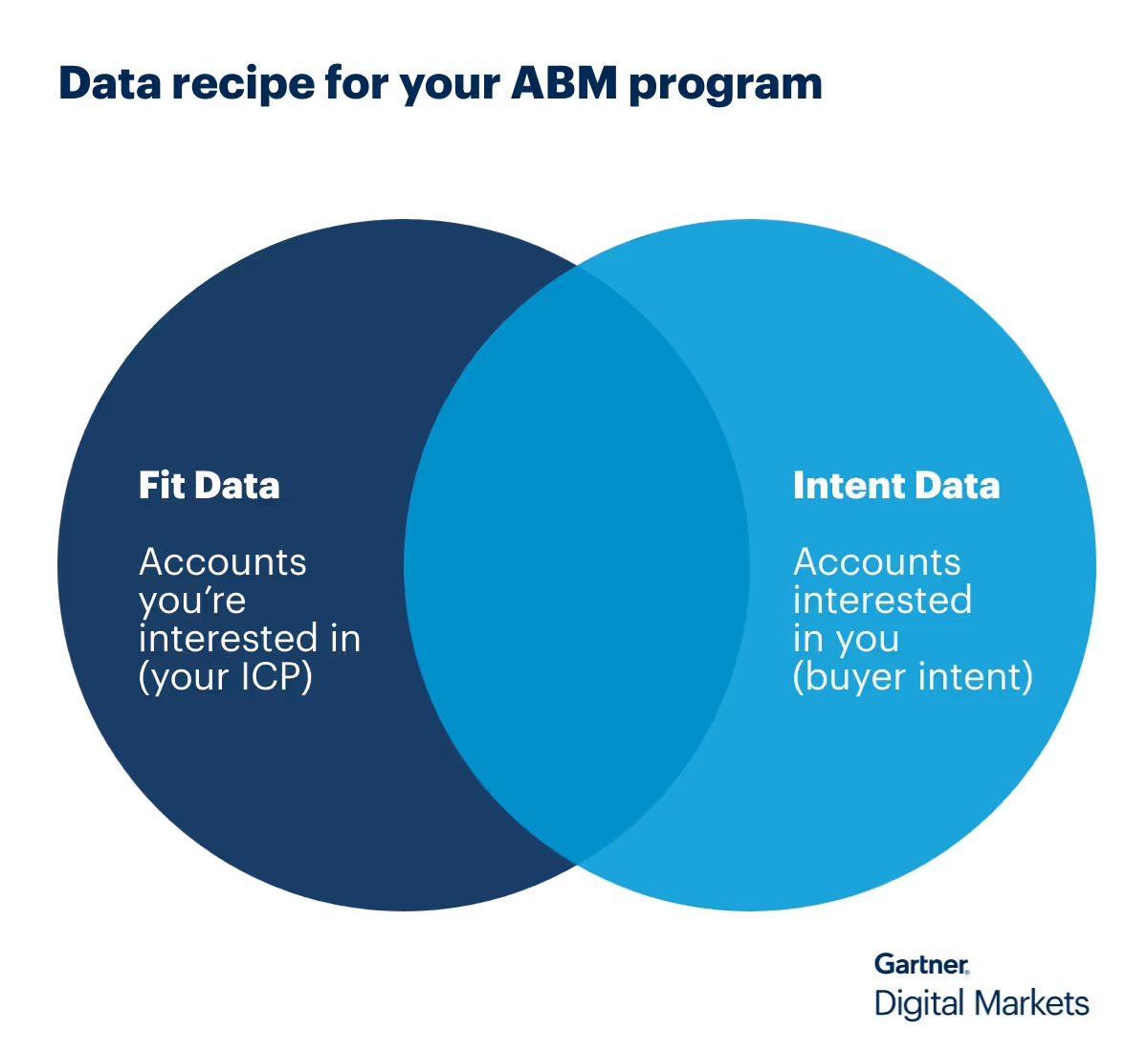
Making Outreach Feel Personal (Without Writing 100 Unique Emails)
Once we had our micro-segments, we designed our outreach ABM strategy:
- Industry-specific landing pages with relevant case studies, industry insights, and tailored messaging.
- Email sequences that felt handcrafted, leading with industry trends and challenges instead of just pushing a demo.
- LinkedIn engagement before outreach, interacting with key decision-makers content before reaching out, so we weren’t just another cold pitch.
The goal was simple: every touchpoint needed to feel personal, even though it was built at scale.
A Multi-Touch, Multi-Channel ABM Approach—Because One Email Isn’t Enough
We knew a single email wouldn’t cut through the noise. Enterprise decision-makers needed multiple interactions across different channels before engaging. So, we built a layered engagement strategy:
- Targeted Email Sequences – Structured sequences built around education, industry pain points, and social proof.
- LinkedIn Engagement – Following decision-makers, interacting with their posts, and warming up the conversation before sending connection requests.
- Retargeting Ads – Running LinkedIn and display ads specifically for these accounts, ensuring consistent brand recall.
- Webinars & Exclusive Events – Hosting discussions tailored to specific industry challenges, making the invite feel exclusive and relevant.
By the time our sales team reached out, we were no longer a cold email in their inbox—they had already seen us, engaged with us, and connected our brand with solving their problem. This 1:few ABM approach had a direct impact on engagement and conversions:
- Higher response rates from outbound efforts because the outreach felt familiar.
- Shorter sales cycles since accounts had already warmed up to the idea before the first real conversation.
- Increased deal velocity—instead of starting from zero, sales teams had key insights to frame the conversation around what mattered most to each account.
Relevance beats volume. Every time. Instead of casting a wide net, targeted, research-driven ABM ensured we were speaking to the right people, in the right way, at the right time.
Also, read→ Top ABM tactics that work in 2025
The Evolution of ABM Research: Modern Tools, Same Principles
Today, while the tools have evolved—AI-driven insights, intent data, and automated personalization—the fundamental principle remains unchanged: deep understanding enables meaningful personalization at scale. Modern ABM research now incorporates:
- Primary research: Customer interviews, Gong recordings, direct feedback from sales teams, and insights from former employees or industry insiders.
- Secondary research: Competitor analysis, market reports, social listening, LinkedIn activity, and job portals.
- Hiring trends analysis: By monitoring job postings, we could gauge upcoming projects, expansion strategies, and investment areas within target accounts.
- Technographic insights: Understanding the tools and technologies in use at an account helped refine messaging to align with their existing infrastructure.
- Intent data: Combining job portal insights with search behaviors and content engagement metrics helped predict when an account was ready to engage.
- AI-driven data analysis: Machine learning models now help identify engagement trends, trigger events, and recommend personalized outreach strategies.
By integrating primary and secondary research with modern tools, companies can ensure their ABM strategies are accurate, relevant, and actionable, enabling hyper-personalization at scale while minimizing manual effort.
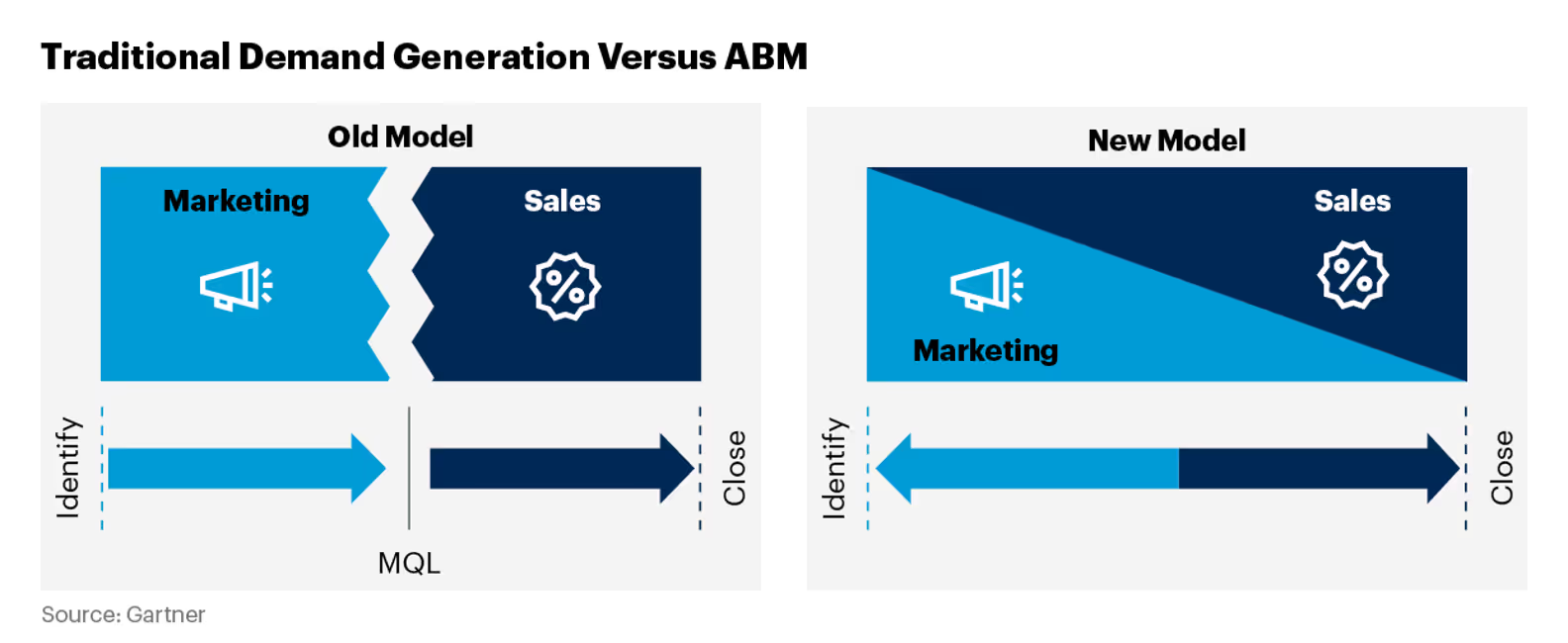
Whether you're using job portals like I did in 2006 or AI-driven insights today, success in 1:Few ABM comes from finding meaningful ways to maintain relevance while scaling your reach. The goal of 1:Few ABM isn't to create unique interactions but to ensure every interaction carries real meaning and value.
How to Build an ABM Strategy for SaaS That Goes Big Without Losing the Personal Touch?
As SaaS organizations grow and markets evolve, there are situations where even broader reach becomes necessary, leading us to the third approach in the ABM framework: 1:Many ABM. This approach allows B2B companies to maintain some degree of personalization while reaching a wider audience efficiently.
The Vymo Challenge
Vymo set an ambitious goal—building a $3M quarterly pipeline while engaging 50 high-value accounts in the Indian banking and insurance sector. Competing in such a saturated market required more than traditional marketing; it demanded a precision-driven 1:Many ABM strategy that combined deep research, personalized outreach, and multi-channel execution. I knew that to make an impact at scale, we had to deeply understand our audience, tailor our messaging, and use multiple engagement touchpoints to ensure we reached the right people at the right time.
Deep Audience Research
To truly step into the buyer’s shoes, I conducted seller interviews and mystery shopping to uncover what decision-makers cared about most. This research revealed:
- The biggest pain points banking and insurance executives faced.
- The exact messaging and offers that resonated with them.
- The gaps in competitors’ strategies, allowing us to position Vymo as the best solution.
- The purchase triggers that prompted decision-makers to explore new solutions.
- The common objections potential buyers had and how to address them proactively.
These insights formed the foundation of our ABM approach, enabling us to create hyper-relevant messaging that cut through the noise.
Precision Targeting for Maximum Impact Using LinkedIn Campaigns
Using LinkedIn as a core channel, I launched a highly targeted campaign tailored to banking and insurance executives. The strategy included:
- High-Value Content: Blogs, white papers, webinars, and case studies designed specifically for this audience.
- Retargeting Strategy: Engaging website visitors and form viewers with follow-up content to keep Vymo top-of-mind.
- Account-Based Ads: Displaying hyper-personalized ads to key stakeholders within target accounts.
- Direct LinkedIn Outreach: Connecting with decision-makers and nurturing conversations through InMail and comments.
Multi-Threading for Faster Conversions
To accelerate deal closures, I implemented a multi-threading strategy—engaging multiple stakeholders within each target account simultaneously. This approach included:
- Hosting targeted workshops to educate decision-makers and nurture relationships.
- Sending personalized gifts to key influencers, building trust, and deepening engagement.
- Multi-Stakeholder Mapping: Identifying and engaging different levels of decision-makers within the same organization to ensure buy-in.
- Sequential Outreach Campaigns: Using automated workflows to nurture leads across multiple touchpoints.
Personalized Email Outreach
Understanding that relationships drive deals, I identified 250 decision-makers (5 per account) and ensured each BDR managed 25 accounts with highly customized email outreach. Using insights from seller interviews, every email felt personal and relevant, increasing response rates and engagement.
- Data-Driven Personalization: Leveraging CRM insights to tailor messaging based on the recipient’s past interactions.
- Follow-Up Cadence Optimization: Ensuring multiple touchpoints at different stages of the buyer’s journey to maintain engagement.
- Custom Call-to-Actions: Each email contained a tailored CTA, whether it was an invitation to a roundtable, an exclusive content piece, or a direct meeting request.
High-Touch Experiences to Build Trust
To further strengthen connections and accelerate deals, I introduced exclusive offline engagement tactics, including:
- Exclusive roundtables that connected key stakeholders and provided a space for in-depth discussions.
- Co-hosted industry events with strategic partners, expanding Vymo’s influence and creating new opportunities.
- VIP Dinners & Networking Events: Inviting high-profile industry leaders to engage in meaningful discussions with Vymo’s sales team.
- Customized Direct Mail Campaigns: Sending high-value prospects tailored physical mail, such as executive reports, personalized notebooks, or invitations to private briefings.
The Results: Driving Real Business Impact
- 500 MQLs generated through LinkedIn campaigns.
- $21M marketing-sourced pipeline from ABM & acceleration campaigns.
- 2% improvement in engagement rates across high-value accounts.
- Increased Sales Velocity: The average deal closure time was reduced by 30% due to multi-threading strategies.
- Higher Conversion Rates: A 12% increase in SQL to opportunity conversion compared to traditional outreach methods.
By implementing a 1:Many ABM approach, I successfully helped Vymo break into a competitive market, build strong relationships with decision-makers, and drive real business impact. This case study is proof that with the right mix of research, personalized outreach, and multi-channel execution, ABM can transform engagement and accelerate growth at scale.
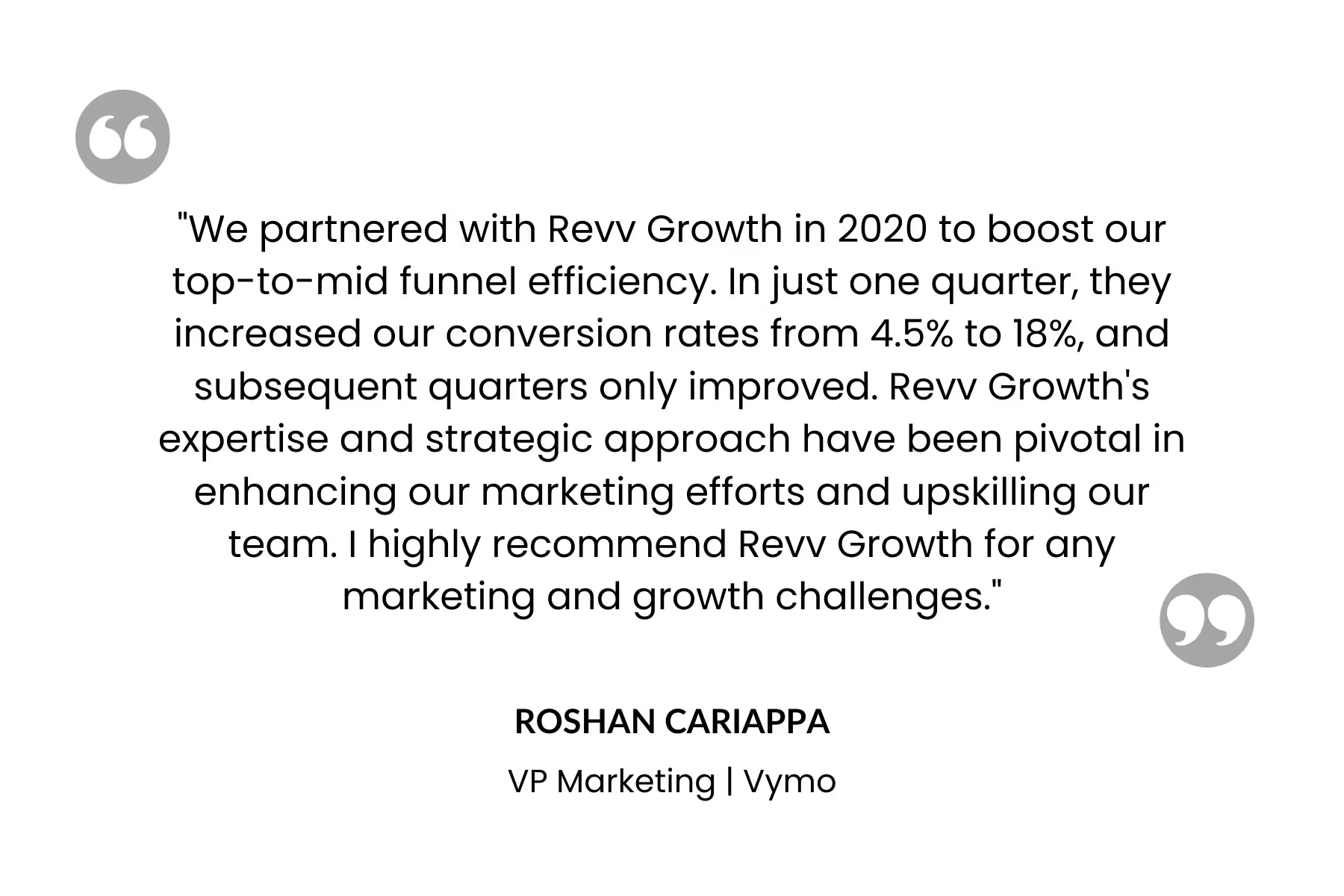
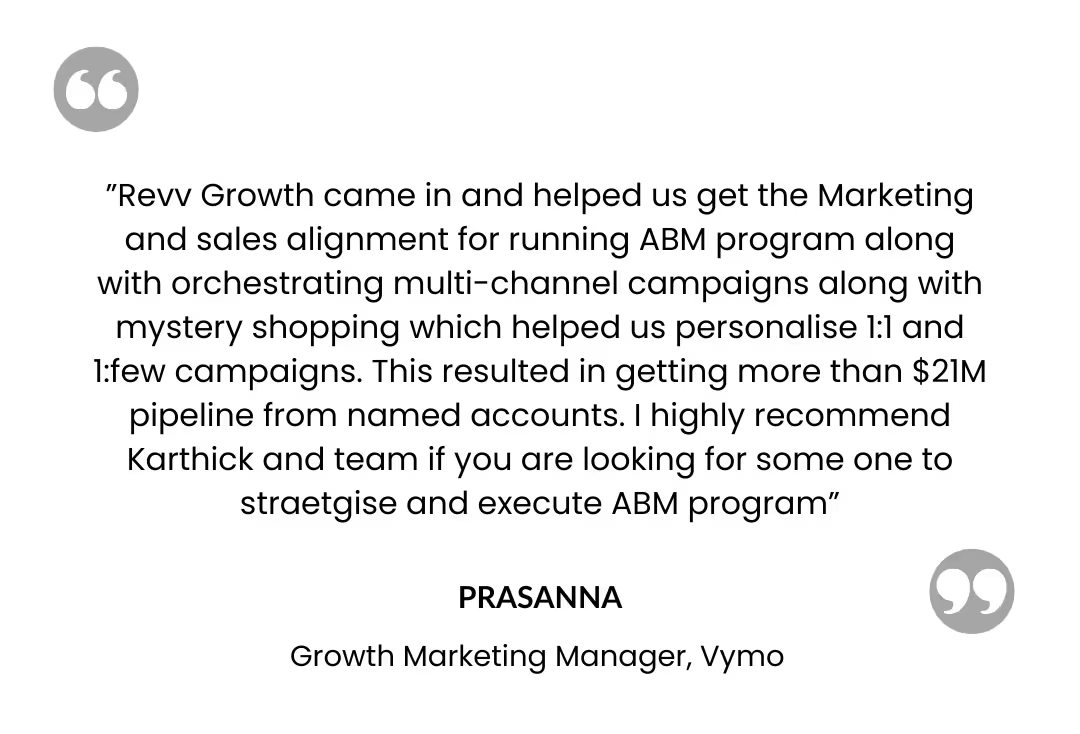
Let's Put These ABM Frameworks to Work for You.
These three approaches to Account-Based Marketing—1:1, 1:Few, and 1:Many—demonstrate the flexibility of account-based marketing. Each approach has its place in modern marketing, and the key is choosing the right strategy based on your goals, resources, and target market. I've shown you how personalization, smart research, and scalable strategies can transform your ABM efforts. Whether you're starting with ABM or looking to improve your existing program, these approaches can help you build stronger relationships and drive better results. So, if you are wondering:
- How to identify the right ABM approach for your current business stage?
- What resources and capabilities do you need for successful implementation?
- How to build an ABM roadmap that aligns with your growth objectives?
Let's talk! Book a free ABM consultation call with me today.

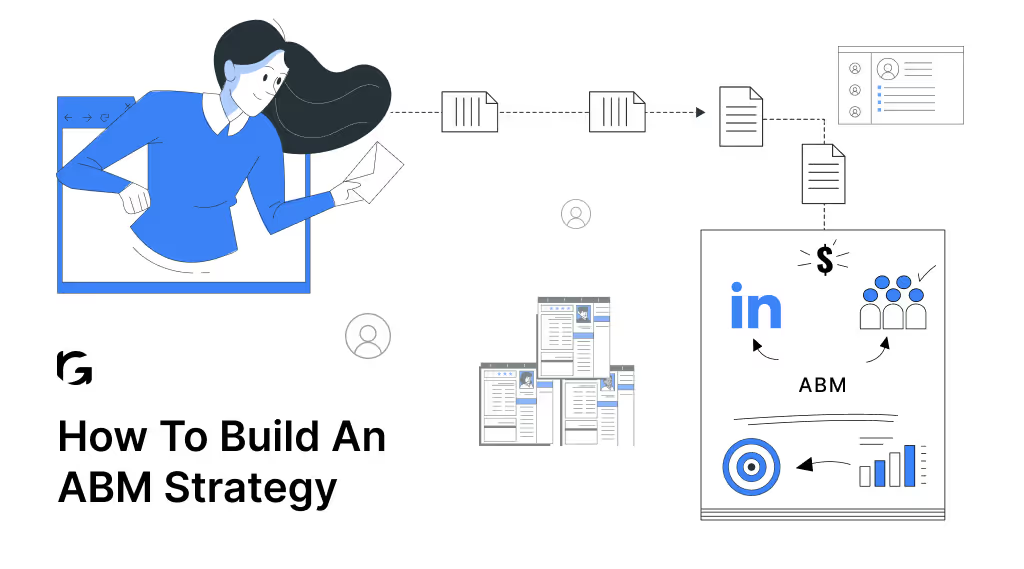

.svg)




.webp)